‘It’s a crisis’: Chronic hoarding is costing some older people their homes
Seniors can be evicted due to unsafe clutter. A San Francisco program is helping them clean up and stay housed.
by Celeste Hamilton Dennis. This story was originally published in The San Francisco Chronicle on February 3, 2024.
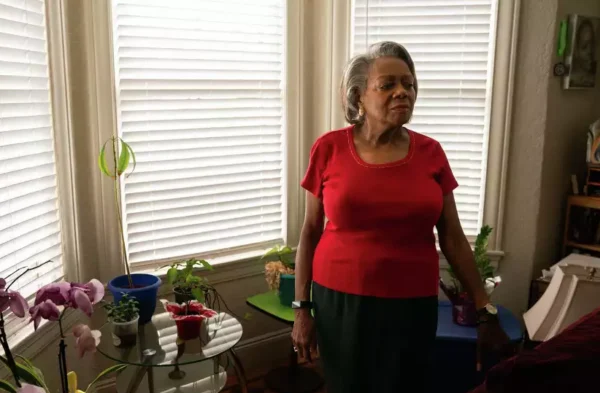
Vera Oliver looks over her San Francisco home in December. After receiving support, Oliver transformed her apartment into a space that is now her refuge. Photo by Florence Middleton.
There are still a handful of vintage hat boxes in Vera Oliver’s closet. Wrapped in smooth satin and crushed velvet, they sit high on a shelf, stacked one on top of another. The boxes are from a time when Oliver worked as a makeup artist at big department stores. She had a gift for eyes, and with one glance could name someone’s best eye shadow color.
At 80 years old, wearing brightly colored porcelain earrings, Oliver still knows beauty when she sees it. She pulls down a box, rubbing her hand over the white satin. “See the bottom?” she asks, pointing to a cloth label inside the box. “Nordstrom’s 1992. This is a collector’s item.”
Oliver used to have a couple of hundred of those boxes; the white satin is one of the few she has saved. She won them at work and used them as giveaways filled with cosmetics for her private clients. But after a while, she had difficulty parting with them.
“That’s how I got in trouble with collecting,” she said. “They each have a story and a memory.”
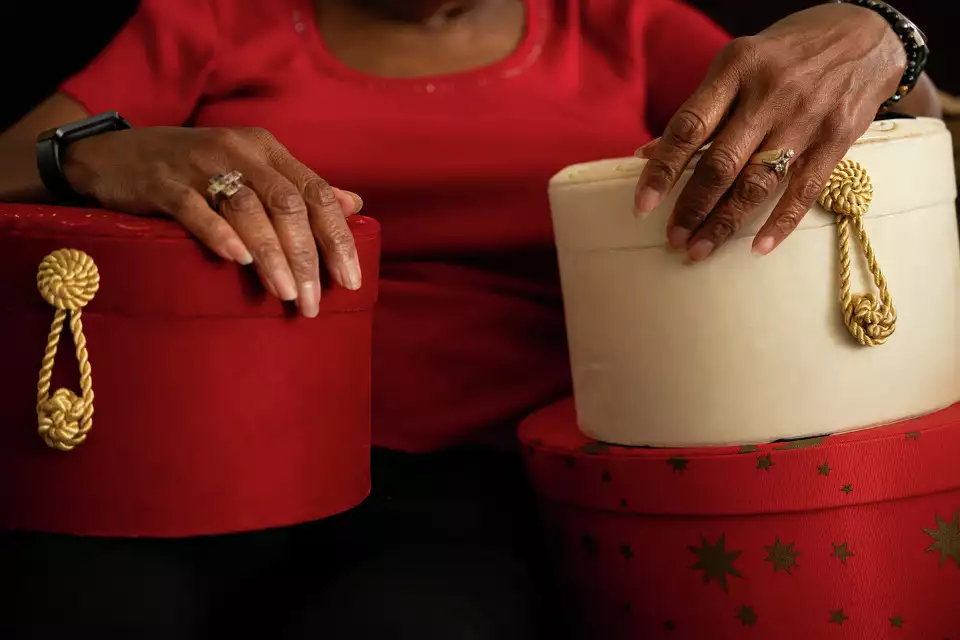
Vera Oliver holds one of her prized possessions — a collection of vintage hat boxes. Photo by Florence Middleton.
Oliver is one of the estimated 12,000 to 25,000 people in San Francisco with hoarding behavior. A stigmatized mental health issue prevalent among older adults, it also can increase risk of eviction. In San Francisco, where the unhoused population is aging, a handful of services are attempting to keep low-income older adults with hoarding behavior out of shelters and off the streets.
“The most frightening noise our participants can hear is the sound of a knock or doorbell,” said Elizabeth Barr, a peer counselor who leads a skills-building and support group for hoarding behavior at the Mental Health Association of San Francisco.
Barr came to the organization more than a decade ago. She and her late husband both had hoarding behavior and they would often fight, yelling at each other: “Your stuff is trash, my stuff is treasure!” Barr was terrified of her landlord discovering their excessive belongings, as she had already been unhoused twice.
Laura Chiera, executive director and managing attorney at Legal Assistance to the Elderly, estimates that about 5% of the 450 or so pro bono eviction lawsuits they defended in 2022 involved hoarding. They receive referrals from the Mental Health Association of San Francisco, the Eviction Defense Collaborative, and the city’s Adult Protective Services department, which provides free short-term case management and crisis intervention for older adults.
“Eviction really is a senior issue,” Chiera said. “It’s a crisis.”
Not like the TV show
Hoarding used to be considered a subtype of obsessive-compulsive disorder. Now it’s a distinct diagnosis that can occur with other disorders. Randy Frost and Gail Steketee — researchers who developed the widely used “Buried in Treasures” treatment curriculum — found people with hoarding behavior often also have depression, anxiety, attention-deficit/hyperactivity disorder, OCD, or post-traumatic stress disorder. Significant loss and trauma can play a role in triggering onset. Other studies suggest it can run in families, presenting itself minimally in childhood and increasing with age.
Growing up in the Boston area, Oliver’s father was a former military man who would regularly read the Boston Globe. Afterward, he would carefully crease its folded edges before stacking it next to the fireplace until it turned brown.
Oliver was more like him in the beginning. When she moved into her small apartment near the Painted Ladies 55 years ago — where she still lives — she would constantly wash the floors. Her closet shelves were filled with cosmetics, organized by color and size. All the labels had to be facing outward.
Perfectionism is a surprisingly common trait, said Monika Eckfield, associate professor and nursing department chair at California State University, East Bay, who has studied older adults with hoarding behavior. Paper, clothing, and books are often the hardest to discard. There’s fear of regret or of things going to the wrong place — clothes ending up in a landfill instead of a consignment store, for example. The frugality of a fixed income, and the challenge of letting go of items attached to a former identity or a loved one who has passed also keep people from throwing things away. And then there is perspective: That bottle cap isn’t trash, it’s one piece in an artful mosaic.
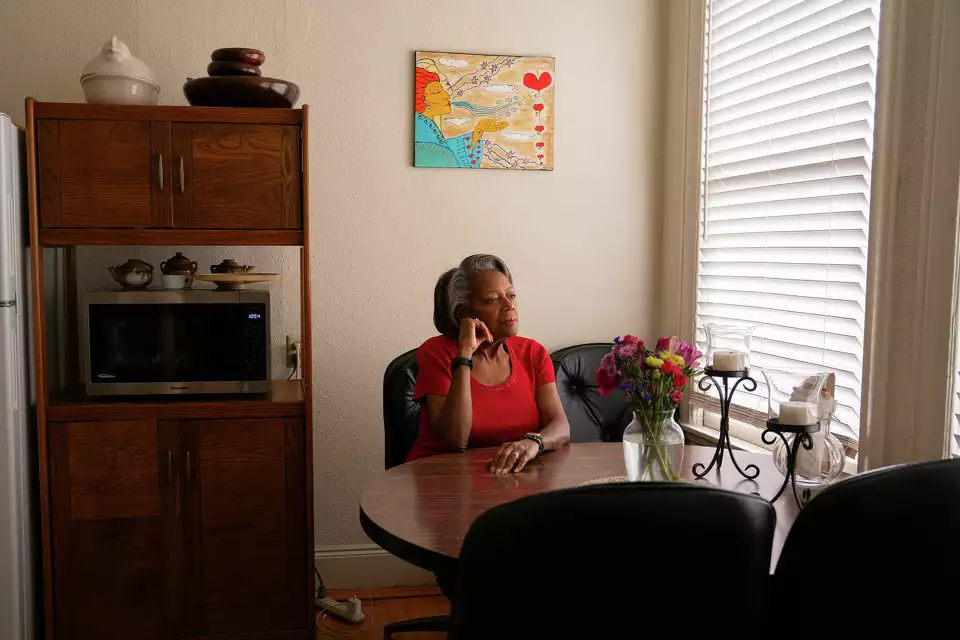
Before receiving support for hoarding, San Francisco resident Vera Oliver had to eat out daily because her kitchen and table were overflowing with clutter. Now, Oliver can now enjoy meals at home. Photo by Florence Middleton.
Chronic health problems or mobility issues that come with aging can make hoarding especially problematic. More stuff means more risk for trips and falls, in addition to the potential health and safety hazards such as fire or pests that put not only the older adult in harm’s way, but other residents if they live in shared housing.
Hoarding behavior often constitutes a disability, giving tenants protection under the Fair Housing Act. But landlords can evict tenants for “nuisance” or breach of contract if the clutter violates health and safety codes.
While television shows like “Hoarders” have peddled the extreme version of hoarding behavior, perpetuating a stereotype of laziness and squalor, the reality is more nuanced.
“There’s a perception that folks with hoarding disorder are living in filth — trash, food, leftovers, dirty dishes everywhere. That, by and large, is not the case,” Eckfield said. “I’ve had so many people I interviewed make it a real point to say, ‘Look, I have a lot of things, but it’s clean.’ ”
Rating clutter
One day more than 30 years ago, when Oliver tried reaching something without using a stool, her neatly organized shelves came tumbling down. Glass shattered everywhere, releasing the pungent smell of nail polish. She closed the door, too overwhelmed. And something in her disconnected.
By the time her 73rd birthday came around, her apartment was a 7 out of 9 on the clutter image rating scale, which distinguishes true hoarding from chronic disorganization. Now, when Oliver pulls up old photos of the clutter on her iPad, she looks at them in disbelief. “I don’t know this person,” she says.
In those photos, teetering boxes of old paperwork line the hallway. Food wrappers cover the kitchen table. Stacks of loose papers sit upon chairs. Plants dry and wilt, unable to see the sun.
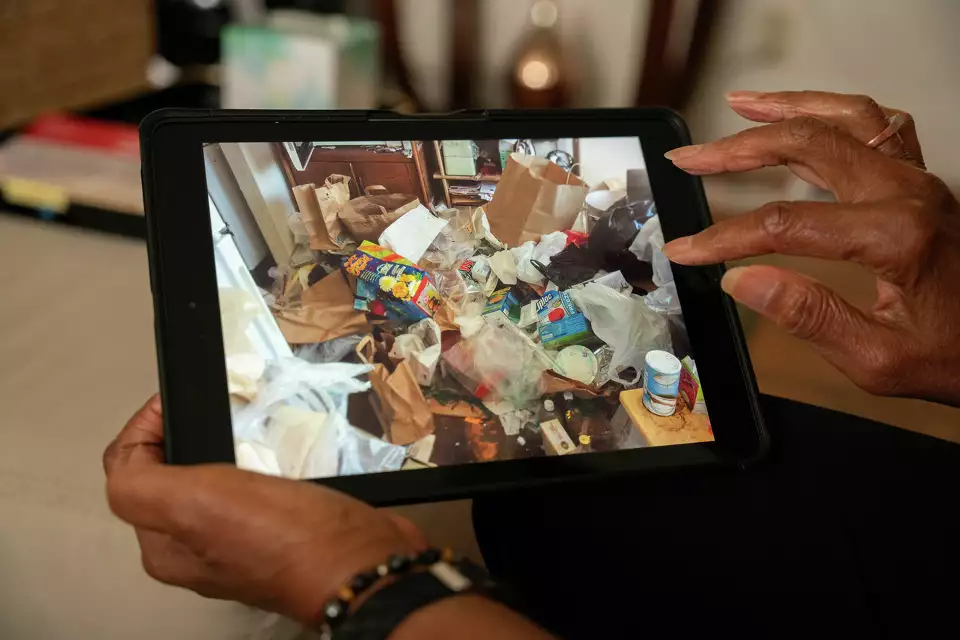
San Francisco resident Vera Oliver shows a photo of what her kitchen table looked like before she sought help for her hoarding. Photo by Florence Middleton.
The clutter was especially bad in the bedroom, where piles of clothes and shoes left no space for Oliver to lie down, so she slept on the living room couch under a knitted red blanket, legs unable to completely stretch because of the clutter.
After a while, Oliver says, she had “clutter blindness.” She went from hosting friends for a home-cooked Sunday seafood feast to making excuses as to why friends and family couldn’t come over.
She rationalized to herself. “If I don’t have company, nobody would know,” she says. “It became my dirty secret.”
A landlady’s kindness
While resources like Clutterers Anonymous exist, people don’t tend to seek treatment unless forced. When they do, real progress can take months or even years. Compare that to the eviction process in San Francisco for nuisance, which starts with a 10-day notice. Legal Assistance to the Elderly will buy time for renters with a hoarding disability using the “reasonable accommodation” defense, and Chiera estimates they have a 90% success rate.
In 2014, Adult Protective Services teamed up with Mental Health Association of San Francisco to run a hoarding intervention pilot for older adults designed to prevent eviction. Modeled on a successful program by the Metropolitan Boston Housing Partnership, the pilot involved 21 participants working one-on-one with a social worker in their homes over the course of 18 months.
“A lot of people are willing to accept help if it’s given in a very thoughtful and respectful way,” said Eckfield, who assisted with the pilot. “And that’s often helping people see their stuff differently and build the capacity to make decisions.”
Right before the pilot, Oliver’s landlady came to check the smoke detectors. Oliver blocked the door, as her biggest fear was being unhoused. She was living check-to-check on Social Security and couldn’t afford to give up her rent-controlled $800-per-month apartment.
But she had known the landlady as a little girl, playing in the hallway while her parents collected rent money, and relented. The landlady walked around the apartment, stepping over piles without judgment. As she was about to leave, she asked, “Vera, do you need help?”
Oliver broke down and cried, nodding her head. Nobody had ever asked her that before.
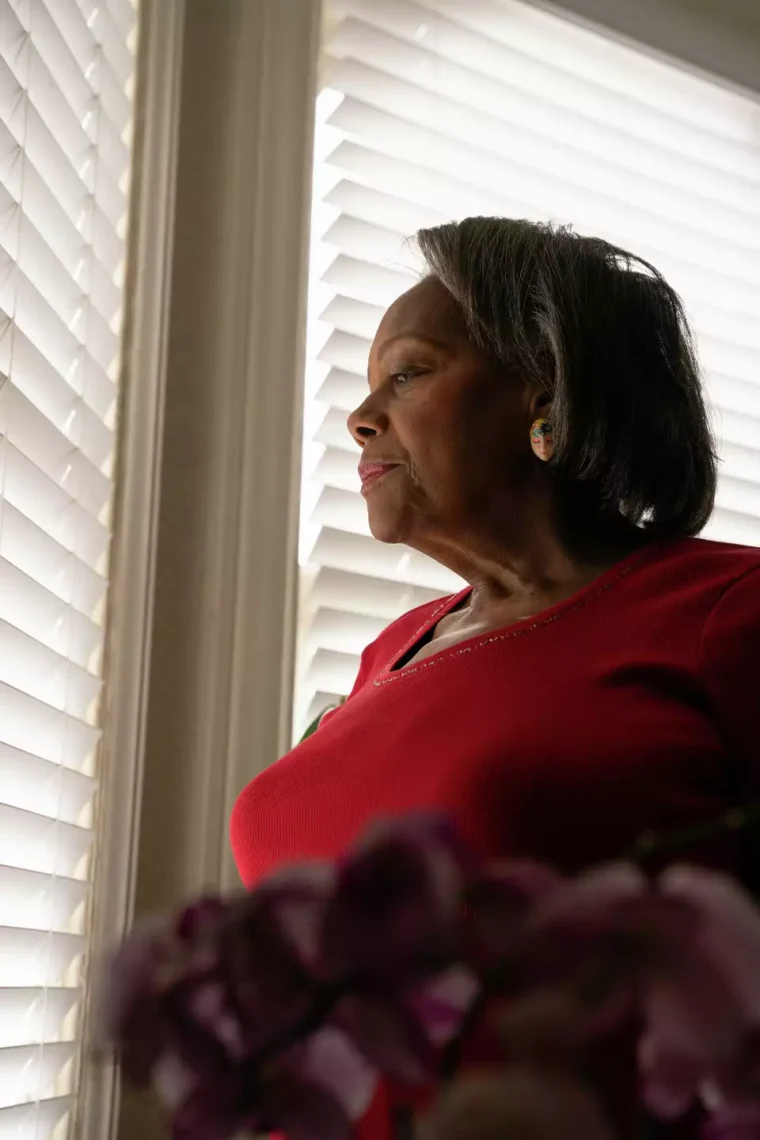
Vera Oliver participated in the Mental Health Association of San Francisco’s hoarder disorder recovery program. After receiving the support, Oliver has transformed her home into to a space that is now her refuge, she said. Photo by Florence Middleton.
She joined the pilot, working with social worker Claudia Sepulveda, who used cognitive behavioral therapy techniques to help Oliver sort items. The overall goal was harm reduction — the home didn’t have to be pristine, but safe enough to live in. First, they addressed code violations, such as removing flammable items stored near heaters or ensuring stockpiles didn’t exceed 4 feet.
A professional clean-out is often the first line of eviction defense and Adult Protective Services offers it for free for those who consent. While it solves immediate eviction and safety hazards, the abrupt removal can feel intrusive. “I didn’t realize how painful the impact is on clients,” Sepulveda said.
The pilot showed the benefit of slow, sustained support. In the end, everyone kept their housing except two participants with severe mental health challenges. It also eventually led to the creation of the Home Safe Unit within Adult Protective Services.
“I thought I was the only one”
Clean-outs are part of the city’s crisis response. It will refer clients with “insight” about their behavior to the Mental Health Association of San Francisco for more intensive one-on-one help and peer-led support groups that have been offered for over 30 years. A 2018 study showed that peer counseling for hoarding behavior was as effective as counseling by clinical therapists.
As for Barr, a peer counselor, she was eventually able to discard the equivalent of 972 bankers’ boxes of stuff and stopped being fearful of the knock on her door. It’s a sentiment others share. In a survey from five years ago with group participants, 85% said they weren’t afraid of eviction anymore.
During the pilot, Oliver had access to the groups, where she met Barr. For her, finding community has been meaningful. “All this time,” she said, “I thought I was the only one.”
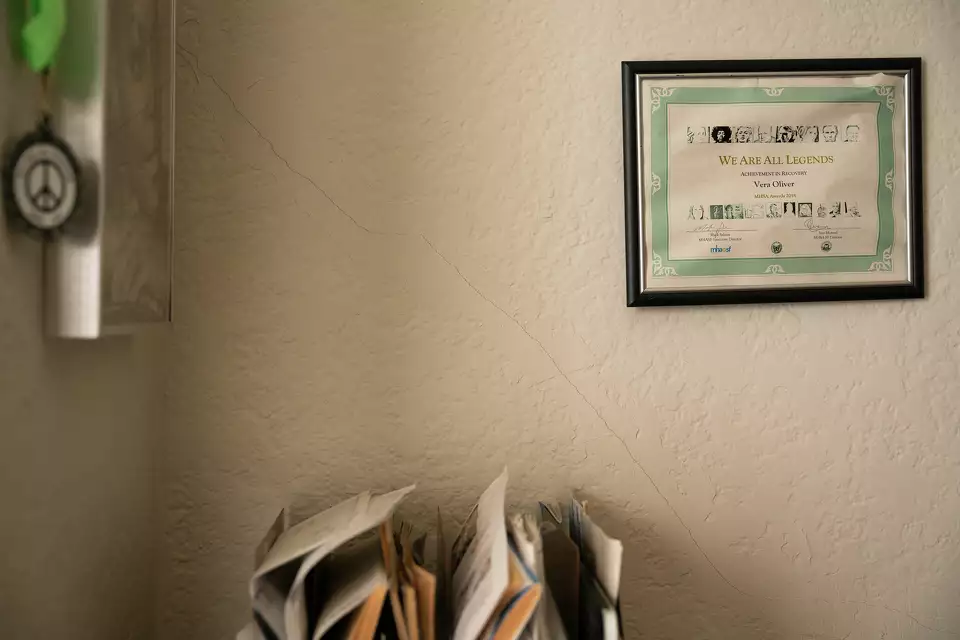
The certificate and medal that Vera Oliver earned by going through the Mental Health Association of San Francisco’s program for hoarding behavior hangs on her wall. Photo Florence Middleton.
Barr said one of the most helpful tools is “clutter buddies” who can hold each other accountable for tasks. When the pandemic happened and the meetings moved to Zoom, she would host decluttering “action parties” for everyone on the call. It wouldn’t be uncommon for Oliver to stay on until midnight — and still isn’t.
Recently, Oliver’s clutter has begun to creep up again on her bedroom dresser. So she leaves her door open when guests come over because she doesn’t want to make excuses or get into the habit of lying. Because hoarding disorders are chronic conditions, Oliver knows managing her clutter will take constant effort.
She’s now the oldest tenant in her building. There’s no elevator, and she worries about what will happen when she can no longer climb the three flights of stairs. For now, Oliver is grateful — for the neighbors who gifted her a cleaner once a month, for the certificate from the Mental Health Association of San Francisco that reminds her of how far she has come.
But all she needs to do is look around her apartment to see how far she has come. She can now eat on her kitchen table. The knitted red blanket drapes neatly over the arm of a new couch. By the bay window, healthy potted plants soak up the sun, among them, a purple orchid that stands tall and proud.
Reporter Celeste Hamilton Dennis and photographer Florence Middleton are with the Investigative Reporting Program at the UC Berkeley Graduate School of Journalism. They covered this story through a grant from the SCAN Foundation.



